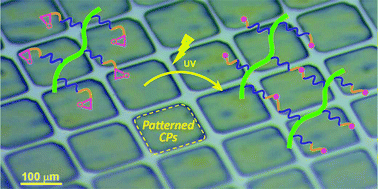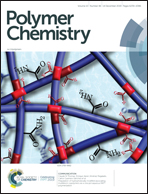Photo-patternable, stretchable and electrically conductive graft copolymers of poly(3-hexylthiophene)†
Abstract
With the increasing demand for new human-device interfaces, the research interest in electronics applications has shifted towards wearable and implantable miniature medical/biomedical devices. These frontier applications require not only such devices to be soft and deformable for conformal contact with the human body, and even tissues, but also the component electronic materials to be easily processable and patternable for simple device fabrication. Although π-conjugated polymers (CPs) have emerged as a promising material class for such applications, their mechanical brittleness and limited patternability have been significant drawbacks. Herein, we developed a novel CP with desired multifunctional features by grafting soft poly(ethylene glycol)methyl ether methacrylate (PEGMMA) side chains with a small amount of photo-crosslinkable glycidyl methacrylate (GMA) side chains on to a conductive poly(3-hexylthiophene) (P3HT) backbone. By incorporating poly(PEGMMA-co-GMA) segments, the graft copolymer exhibits excellent mechanical stretchability, up to 150% strain, as well as water-swellability, while maintaining doping/dedoping capability and thus sufficient electrical conductivity originating from conjugated P3HT segments. Moreover, the introduction of epoxy-bearing GMA segments allows us to demonstrate the micro-patterning of graft copolymer films through the photo-crosslinking process. This work provides a simple and facile methodology to prepare multifunctional stretchable, photo-patternable and electrically conductive polymers for versatile organic electronics and bioelectronics.

- This article is part of the themed collection: Chemical Advances in Additive Manufacturing


 Please wait while we load your content...
Please wait while we load your content...